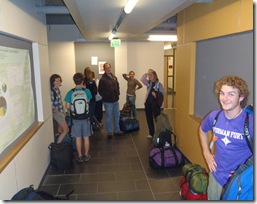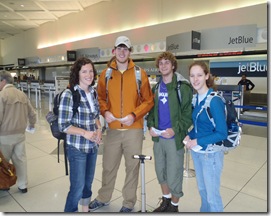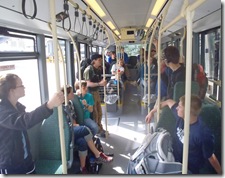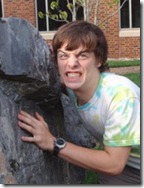Today we had a guide from the Icelandic GeoSurvey, Draninn Fredriksonn, who took us around to different sites of geologic interest in the Reykjanes Peninsula. Our first site was “Bridge between the two Continents”, which was basically a rift zone that has several en-echelon faults that are part of the Reykjanes Rift Zone. Even though this site is not literally representing the center of the active rift zone that separates North American continent from Eurasian continent, it was really nice to see the what a rift zone looks like. We noticed a lot of aeolian black sand (with shell fragments blown from the ocean by wind) deposits at the grabbens and the basaltic rocks had large vesicles and some alveolar weathering features. Students enjoyed jumping from the top of the basaltic flow to the soft sand below.
(Click on the image to see larger version)
We then visited two recent volcanic cinder cone craters, that erupted in 1300’s. They had very light weight scoria (as light as pumice stone) and showed beautiful ropy, pahoe-hoe lava structure. We walked on the lava field, explored the spatter cone, discussed the composition and origin of layering on the rim of the cones. We also noticed lava tube in several places.
From there, we drove a short distance to the lighthouse and studied pillow basalts (indicating under water volcanic eruption) along the shoreline, then walked north from there along the shoreline observing shoreline changes, basaltic dykes, and a really nice stratified volcanic ash deposit that formed several meters high cliff along the shore.
By this time, we were getting hungry (it was about 2pm), so drove to the nearby Grindavik town and had a good fast food lunch. It was much better than any other fast food we have in the US. After eating, we drove to the most popular “Blue Lagoon”, which is a hot spa, naturally heated outdoor pool. Apparently the hydrothermal power plants produces a lot of waste water (water that is left after separating the steam to generate electricity) that is very rich in minerals, particularly silica. This water is pooled outside the power plant, and as it cools silica precipitates as a fine sludge giving the beautiful blue color. It’s incredible beautiful, and what a way to make money of a waste product.
The final stop for the was at the geothermal field in Krysuvik-Seltus. We saw some boiling mud and hot and steamy springs. Most of them were at or above boiling temperature and very acidic and had a strong hydrogen-sulfide smell (like rotten egg!). It was really cool to see the boiling water coming out of the ground and flowing down as a stream. What a great site – this was just one of many that are in the area. Several hydrothermal power plants are located in the region. We will be visiting one of them tomorrow. This is it for now. Please visit the album below to see a few sample photos.








